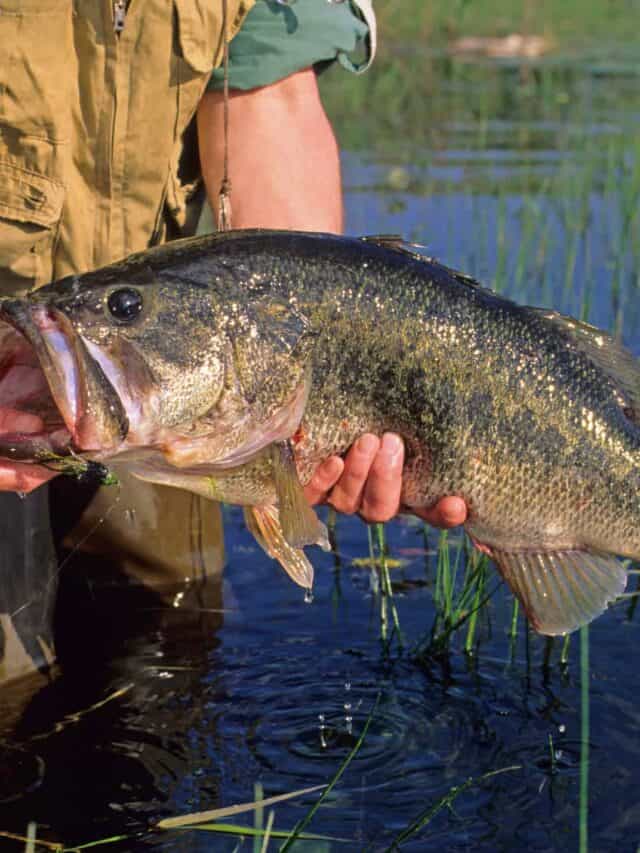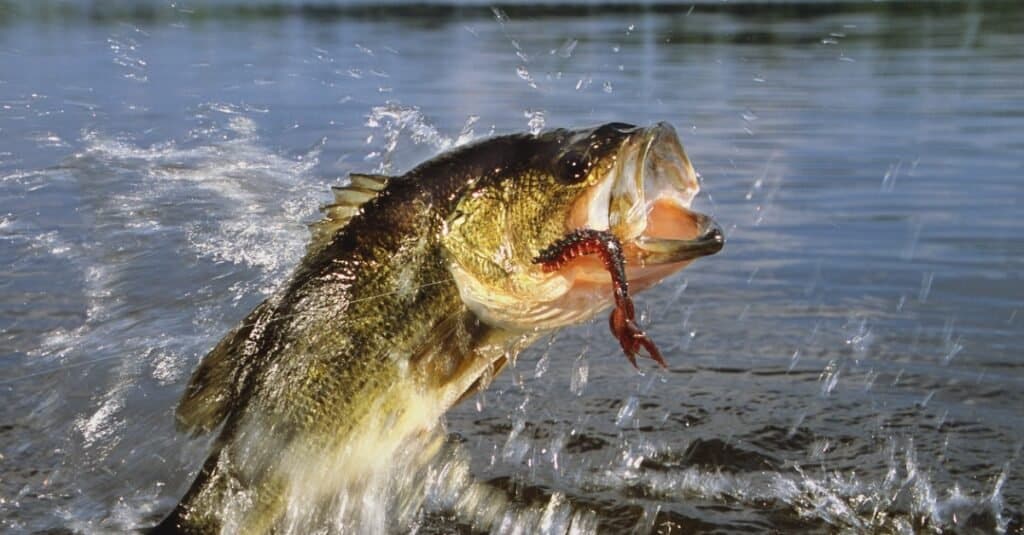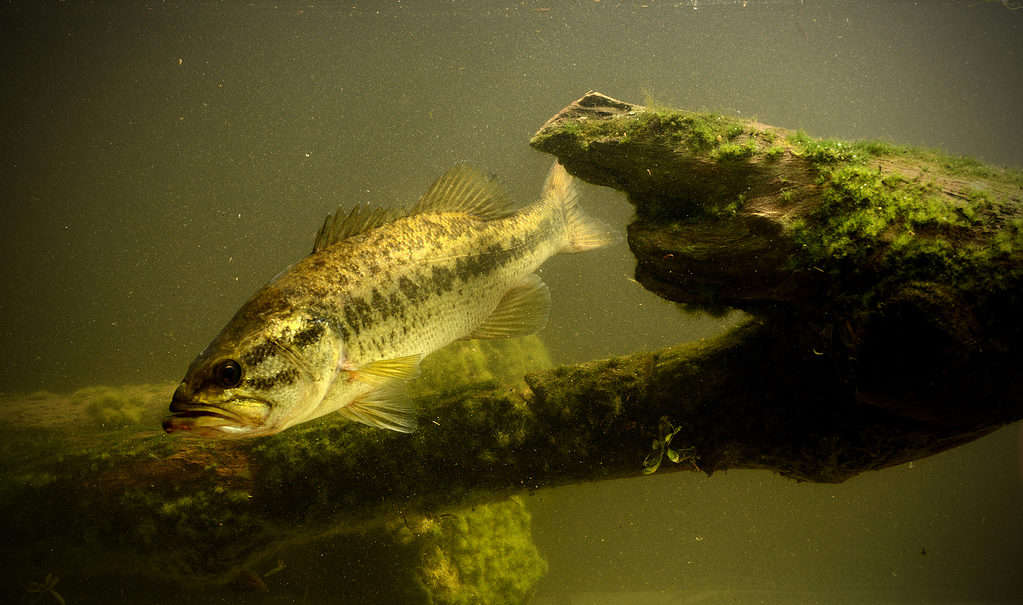The largemouth bass is a large, powerful carnivorous fish that has a reputation for eating virtually anything they come across. Given their powerful nature, they are also one of the most popular and prized fish among anglers. The largemouth bass is famous for its stunning acrobatic displays as they resist capture and for the impressive sizes that they can reach. But just how big do they get? Join us as we discover the largest largemouth bass ever caught!
About Largemouth Bass

The largemouth bass is an active, acrobatic fish.
©Ryno Botha/Shutterstock.com
The largemouth bass is large freshwater fish native to the United States, Canada, and Mexico. They have also been introduced to many other parts of the world due to their popularity as game fish. The largemouth bass is a member of the Centrarchidae family group, typically known as sunfishes. Along with largemouth bass, many other members of this family group are popular for sport fishing. They are greenish-gray with a horizontal black stripe down each side. They weigh anything up to 25 pounds with lengths of up to 30 inches, with females being larger than males. They get their name from the appearance of their mouth as the corners extend beyond their eye. Their lower jaw is also slightly longer than their upper jaw.
Largemouth bass can live in virtually any freshwater habitat – including ponds, swamps, rivers, and lakes. They can even live in estuaries. However, in all habitats, they typically live in warm water between 27 and 30°C and at depths less than 19 feet.
As they live in so many freshwater habitats, largemouth bass have a wide and varied diet. They are carnivorous and eat a wide range of fish, frogs, salamanders, birds, and turtle hatchlings. They are one of the most aggressive predators and vicious predators, eating anything up to around 50% of their own size. As they prey on so many different fish species, they have quickly become classed as an invasive species in many countries where they have been introduced. This is because they have caused a decline in many native fish populations. Incredibly, largemouth bass is able to create suction when eating their prey. This is because they open their mouth wide and flair their gills which creates a vacuum and suction to suck in their prey.

Largemouth bass are one of the most prized game fish because they put up such an impressive fight.
©iStock.com/stammphoto
As Sport Fish
Largemouth bass are one of the most popular game fish and are highly prized by anglers. They put up impressive fights once hooked and vigorously resist being caught. They regularly leap into the air during a fight. This is in an attempt to release themselves, but giving a stunning acrobatic display in the process. Largemouth bass shakes their heads with their mouth gaping open. They then launch themselves into the air in an attempt to release themselves from the hook. They even often continue to fight once caught. In warmer water, they tend to be more active. This means that they put up a greater fight than those in cooler water. The nature of the fight that largemouth bass put up is often credited with being the reason that many fishermen become addicted to fishing.
As female largemouth bass are larger than males, they are usually the fish that are captured more often. The breeding of females is highly important to the continued health of the population for years to come. Therefore, catch and release is highly encouraged to help preserve the population. This method is viewed to be a success as largemouth bass have good survival rates after being caught and released back into the water.
The Largest Largemouth Bass ever Caught

The largest largemouth bass was 22 pounds, 5 ounces.
©iStock.com/stammphoto
The largest largemouth bass ever caught weighed an incredible 22 pounds and 5 ounces. The gigantic fish was caught in 2009 in Lake Biwa, Japan. Spanning a vast 259 square miles, Lake Biwa is Japan’s largest lake. It is home to a vast amount of fish – especially bass and trout. The largemouth bass is actually classed as an invasive species in Japan. Authorities are actively trying to eradicate them from the lake. The massive bass was caught by angler Manabu Kurita who initially thought his monster catch was only around 13 pounds. However, pictures clearly show its incredible size with its huge belly and massive mouth.
Ironically, although Kurita’s catch is the largest ever caught, it is not classed as the outright world record by the International Game Fish Association (IGFA). Instead, it is classed as a tie with a 22-pound, 4-ounce fish. This is because IGFA rules state that any fish under 25 pounds must surpass the previous record-holder by at least 2 ounces. And even then Kurita had to take a polygraph test just for his claim to be verified.
Despite this, Kurita’s largemouth bass is undoubtedly an impressive catch – especially as it has taken 77 years for anyone to even tie for the title. That’s right, no one had caught a largemouth bass as large since 1932! The 1932 catch by George Perry in Lake Montgomery, Georgia is not without its own story as world records for fishing didn’t even exist at the time. Instead, Perry entered and won a big fish contest run by Field & Stream magazine using only the measurements and no pictures. Therefore, when world records began to be noted two years later, Perry’s bass was automatically recorded!

Largemouth bass hatchlings eat zooplankton and progress to insects and eventually to other fish as they grow larger.
©iStock.com/FtLaudGirl
From Tiny Hatchlings to World Record Size
Although it might seem surprising, given the sizes that they reach as adults, largemouth bass begin life as tiny, transparent hatchlings that are only 3mm long. Females lay anything from 2,000 to 145,000 eggs which the male guards until they hatch after 3 to 7 days. The tiny hatchlings remain in the nest for approximately another week before they change to their typical greenish color. By this time they are around 0.25 inches long and begin to feed on zooplankton. As they continue to grow they begin to eat insects and eventually fish.
Largemouth bass are sexually mature at one year old, by which time they weigh around 2 pounds. Although they grow to incredible sizes, it takes time for them to reach that size. For example, a 5-pound largemouth bass is usually around 6 years old. However, largemouth bass can live for up to 16 years in the wild which gives them plenty of time to reach world-record sizes.
The photo featured at the top of this post is © iStock.com/stammphoto
Thank you for reading! Have some feedback for us? Contact the AZ Animals editorial team.







